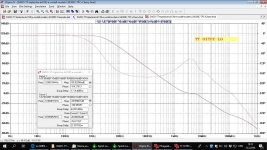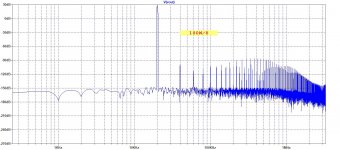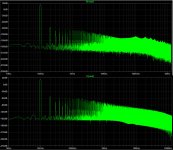My agenda is democratisation of ABX testing in the context of a DIY audio forum, why should anyone else's agenda conflict with that? 🙂
It may be conflicting with yourself. At one point, you want to 'punish' people with the ABX. This will make it difficult for you to understand what MMerill is saying when it sounds like he is disagreeing with you. Actually, what he is saying is far beyond what many here can comprehend, especially with the wrong attitude towards learning.
Yes, I know, but I didn't realized the benefit of the compensation scheme back then. That's why I asked the benefit of the complex compensation as I could do with one cap, -0dB up to 1kHz and the 20kH THD is even better. Now I realized that with using your compensation scheme I would have less compromises. I don't think this compensation has timing issues as it works on 'VHF' but I'm not decided yet whether it will present difficult load for the front end or not.
This is my ThermalTrak VFA Loop Gain with OITPC. Not flat up to 20kHz but has 80dB of feedback at 20kHz very low THD20k, and it's very stable, but I still prefer CFA. By the way TT amp with TMC has 60dB of feedback at 20kHz.
Attachments
Last edited:
This is my ThermalTrak VFA Loop Gain with OITPC. Not flat up to 20kHz but has 80dB of feedback at 20kHz very low THD20k, and it's very stable, but I still prefer CFA.
If a VFA can be designed to approach the technical 'quality' of CFA, why do you prefer CFA? Can you HEAR differences (or just because it is easier)? I remember about the VFA versus CFA debate. Imo, as long as one know how to design a VFA, there should be no difference between them. Unfortunately though, I haven't seen any single VFA that complies.
and it's very stable,
Yes, I can see your trick to 'bump' the response/phase pass the ULGF.
Did you mean to say "blind testing" instead of "ABX testing" or are you fixated on ABX testing?My agenda is democratisation of ABX testing in the context of a DIY audio forum, why should anyone else's agenda conflict with that? 🙂
I've often seen the argument made on audio forums that preference testing should not be done as difference testing is needed first - the logic escapes me (if it is truth we are searching for)
If a VFA can be designed to approach the technical 'quality' of CFA, why do you prefer CFA? Can you HEAR differences (or just because it is easier)? I remember about the VFA versus CFA debate. Imo, as long as one know how to design a VFA, there should be no difference between them. Unfortunately though, I haven't seen any single VFA that complies.
Current on demand, inherently symmetric circuit (simpler by this) and no bump at the output at switch on. As the feedback is low impedance it's less dependent on a stray inductance/capacitance.
I'm just into maximum forum participation, whichever test can do that most successfully, why not? 😉Did you mean to say "blind testing" instead of "ABX testing" or are you fixated on ABX testing?
I've often seen the argument made on audio forums that preference testing should not be done as difference testing is needed first - the logic escapes me (if it is truth we are searching for)
The resistance to ABX testing reminds me some negative response to the activity of
Articles, Reviews and Measurements of Audio Products (As an Amazon Associate I earn from qualifying purchases) | Audio Science Review (ASR) Forum
Master SINAD (distortion) Comparison Graph for DACs | Audio Science Review (ASR) Forum
This guy is doing a great job and he has very good test equipment. Of course, some manufacturers are not happy with the results of their products. Similar as some "Manufacturer's comments" to Atkinson's tests in Stereophile. This is similar to ABX rejection. If the result is against expectations, protests of involved people may be expected.
Yes, I know what is the difference between blind tests and ABX. I have abandoned sighted blind tests few years ago, they are not giving a feedback that is neutral enough.
Articles, Reviews and Measurements of Audio Products (As an Amazon Associate I earn from qualifying purchases) | Audio Science Review (ASR) Forum
Master SINAD (distortion) Comparison Graph for DACs | Audio Science Review (ASR) Forum
This guy is doing a great job and he has very good test equipment. Of course, some manufacturers are not happy with the results of their products. Similar as some "Manufacturer's comments" to Atkinson's tests in Stereophile. This is similar to ABX rejection. If the result is against expectations, protests of involved people may be expected.
Yes, I know what is the difference between blind tests and ABX. I have abandoned sighted blind tests few years ago, they are not giving a feedback that is neutral enough.
Last edited:
Current on demand, inherently symmetric circuit (simpler by this) and no bump at the output at switch on. As the feedback is low impedance it's less dependent on a stray inductance/capacitance.
Ok, thanks. "As the feedback is low impedance...", the effort to address this is what we rarely see with VFA.
Not sure I understand what "sighted blind tests" are - maybe I've lost my sense of humour again?
The important words in my original message you quoted were:No. VFA can have loop gain flat until 10kHz and higher. For example is amplifier that using OITPC compensation by Dadod.
"if you keep impedance of the feedback path high enough in order to keep the LTP balanced"
Of course, Dadod says exactly the same thing:
John Curl's Blowtorch preamplifier part III
Last edited:
I'm just into maximum forum participation, whichever test can do that most successfully, why not? 😉
OK, you're just into participation, not investigating/learning about all aspects of audio replay & perception?
If just maximum forum participation was your goal then you should be against shutting down people's reports of their listening impressions.
Maybe you're stated goal is not really your goal?
The important words in my original message you quoted were:
"if you keep impedance of the feedback path high enough in order to keep the LTP balanced"
Of course, Dadod says exactly the same thing:
John Curl's Blowtorch preamplifier part III
Dadod said about CFA. But you said VFA can not have open loop gain flat until 10kHz, which is wrong. Loop gain = (open loop gain) - (close loop gain).
OK, you're just into participation, not investigating/learning about all aspects of audio replay & perception?
If just maximum forum participation was your goal then you should be against shutting down people's reports of their listening impressions.
Maybe you're stated goal is not really your goal?
You must be getting me confused with someone else. As regards forum listening tests, yes I'm into maximum participation, have you seen how few people participate positively? I don't see the point in constantly trashing them. They cannot be conducted to the standard demanded by you, Mark and Jakob, that's impossible, the tests are more like herding cats, they are what they are, call them "a bit of fun" if you want, so what?
Dadod said about CFA. But you said VFA can not have open loop gain flat until 10kHz, which is wrong. Loop gain = (open loop gain) - (close loop gain).
This is loop gain of VFA:
https://www.diyaudio.com/forums/solid-state/317335-oitpc-output-inclusive-tpc-tmc-9.html#post5555935
I guess you will never understand the difference between measuring audio electronics & audio perception despite the constant pointing out of this basic fact.The resistance to ABX testing reminds me some negative response to the activity of
Articles, Reviews and Measurements of Audio Products (As an Amazon Associate I earn from qualifying purchases) | Audio Science Review (ASR) Forum
Master SINAD (distortion) Comparison Graph for DACs | Audio Science Review (ASR) Forum
This guy is doing a great job and he has very good test equipment. Of course, some manufacturers are not happy with the results of their products. Similar as some "Manufacturer's comments" to Atkinson's tests in Stereophile. This is similar to ABX rejection. If the result is against expectations, protests of involved people may be expected.
Yes, I know what is the difference between blind tests and ABX. I have abandoned sighted blind tests few years ago, they are not giving a feedback that is neutral enough.
Some people are just not interested in absorbing/learning new information.
Exactly - they are no better or no worse than sighted listening - just a bit of fun, right? Now see how many people won't accept this?You must be getting me confused with someone else. As regards forum listening tests, yes I'm into maximum participation, have you seen how few people participate positively? I don't see the point in constantly trashing them. They cannot be conducted to the standard demanded by you, Mark and Jakob, that's impossible, the tests are more like herding cats, they are what they are, call them "a bit of fun" if you want, so what?
Are any real measurements (THD vs. freq, CCIF.. with various load and power) available?This is my ThermalTrak VFA Loop Gain with OITPC. Not flat up to 20kHz but has 80dB of feedback at 20kHz very low THD20k, and it's very stable, but I still prefer CFA. By the way TT amp with TMC has 60dB of feedback at 20kHz.
The question seems very thorethical, on my point of view, as most (all ?) modern solid state power amps use GNFB.Bob Cordell picked that up in his book*. He convincingly showed that in a modern, reasonably linear amp to start with, feedback clearly reduced ALL harmonics, not creating new ones either.
I have posted the relevant graphs repeatedly at diyaudio. Unfortunately, those who's agenda is furthered by misleading the audience will not be interested at all in the real facts so they never get mentioned. And so the misconceptions are propagated.
More important for me is this question: are harmonic distortions components that are situated out of our audible range and out of the bandwidth a tweeter is able to reproduce (>20 000 Hz) audible ?
Attachments
- Status
- Not open for further replies.
- Home
- Member Areas
- The Lounge
- John Curl's Blowtorch preamplifier part III



